1994 CADILLAC ELDORADO ESP
[x] Cancel search: ESPPage 196 of 398
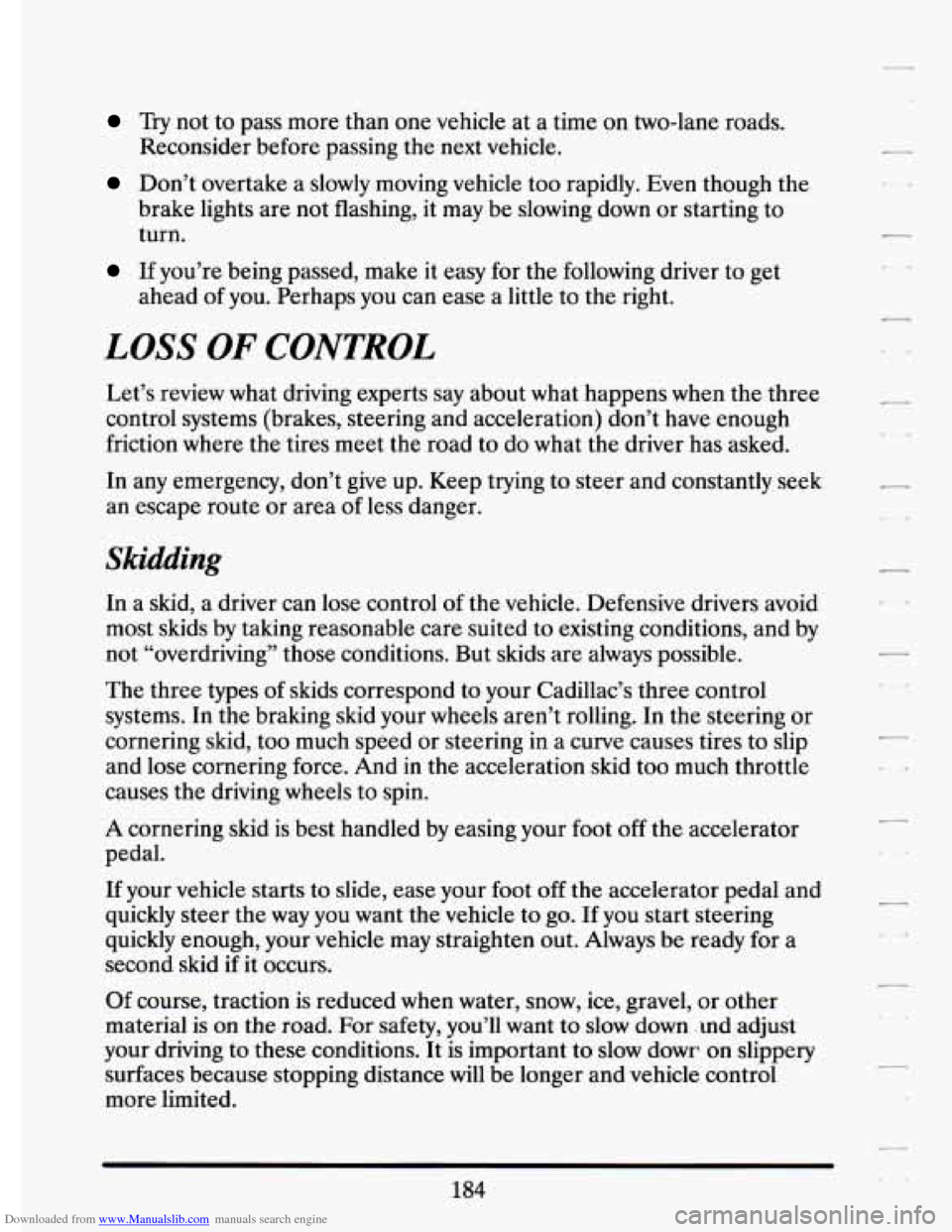
Downloaded from www.Manualslib.com manuals search engine Try not to pass more than one vehicle at a time on two-lane roads.
Reconsider before passing the next vehicle.
Don’t overtake a slowly moving vehicle too rapidly. Even though the
brake lights are not flashing, it may be slowing down or starting to
turn.
If you’re being passed, make it easy for the following driver to get
ahead
of you. Perhaps you can ease a little to the right.
LOSS OF CONTROL
Let’s review what driving experts say about what happens whe\
n the three
control systems (brakes, steering and acceleration) don’t ha\
ve enough
friction where the tires meet the road to do what the driver has asked.
In any emergency, don’t give up. Keep trying to steer and constantly seek
an escape route or area of less danger.
Skidding
In a skid, a driver can lose control of the vehicle. Defensive drivers avoid
most skids by taking reasonable care suited to existing conditions, and by
not “overdriving” those conditions. But skids are always possible.
The three types of skids correspond
to your Cadillac’s three control
systems. In the braking skid your wheels aren’t rolling.
In the steering or
cornering skid, too much speed or steering
in a curve causes tires to slip
and lose cornering force. And in the acceleration skid too much throttle
causes the driving wheels to spin.
A cornering skid is best handled by easing your foot off the accelerator
pedal.
If your vehicle starts to slide, ease your foot off the accelerator pedal and
quickly steer the way you want the vehicle
to go. If you start steering
quickly enough, your vehicle may straighten out. Always be ready for a
second skid if it occurs.
Of course, traction is reduced
when water, snow, ice, gravel, or other
material is on the road. For safety, you’ll want
to slow down .md adjust
your driving
to these conditions. It is important to slow dowr on slippery
surfaces because stopping distance will be longer and vehicle control
more limited.
184
Page 198 of 398
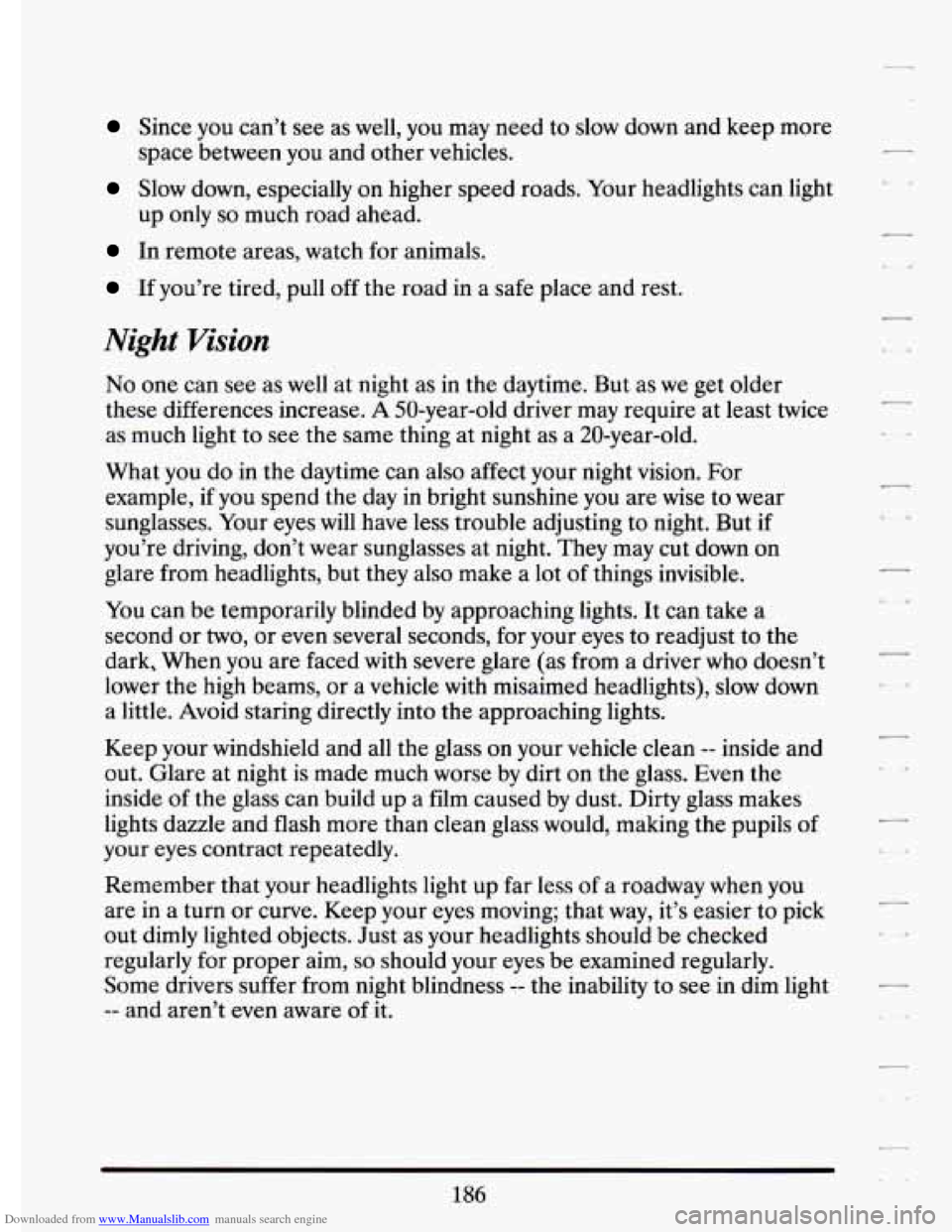
Downloaded from www.Manualslib.com manuals search engine Since you can’t see as well, you may need to slow down and keep more
space between
you and other vehicles.
Slow down, especially on higher speed roads. Your headlights ca\
n light
In remote areas, watch for animals.
If you’re tired, pull off the road in a safe place and rest.
up only
so much road ahead.
Night Vision
No one
can see as well at night as in the daytime. But as we get older
these differences increase.
A 50-year-old driver may require at least twice
as much light to see the same thing at night as a 20-year-old.
What you do in the daytime can also affect your night vision. For
example,
if you spend the day in bright sunshine you are wise to wear
sunglasses. Your eyes
will have less trouble adjusting to night. But if
you’re driving, don’t wear sunglasses at night. They may cut down on
glare from headlights, but they also make
a lot of things invisible.
You can be temporarily blinded by approaching lights. It can take a
second or
two, or even several seconds, for your eyes to readjust to the
dark, When you are faced with severe glare (as from a driver who doesn’t
lower the high beams, or a vehicle
with misaimed headlights), slow down
a little. Avoid staring directly into
the approaching lights.
Keep your windshield and all the glass on your vehicle clean
-- inside and
out. Glare at night is made much worse by dirt on the glass. Even the
inside of the glass can build up a film caused by dust. Dirty glass makes
lights dazzle and flash more than clean glass would, making the pupils of
your eyes contract repeatedly.
Remember that your headlights light up far less
of a roadway when you
are in a turn or curve. Keep your eyes moving; that way, it’s easier to pick
out dimly lighted objects. Just as your headlights should be checked
regularly for proper aim,
so should your eyes be examined regularly.
Some drivers suffer from night blindness
-- the inability to see in dim light
-- and aren’t even aware of it.
-
c -4
186
..
Page 216 of 398
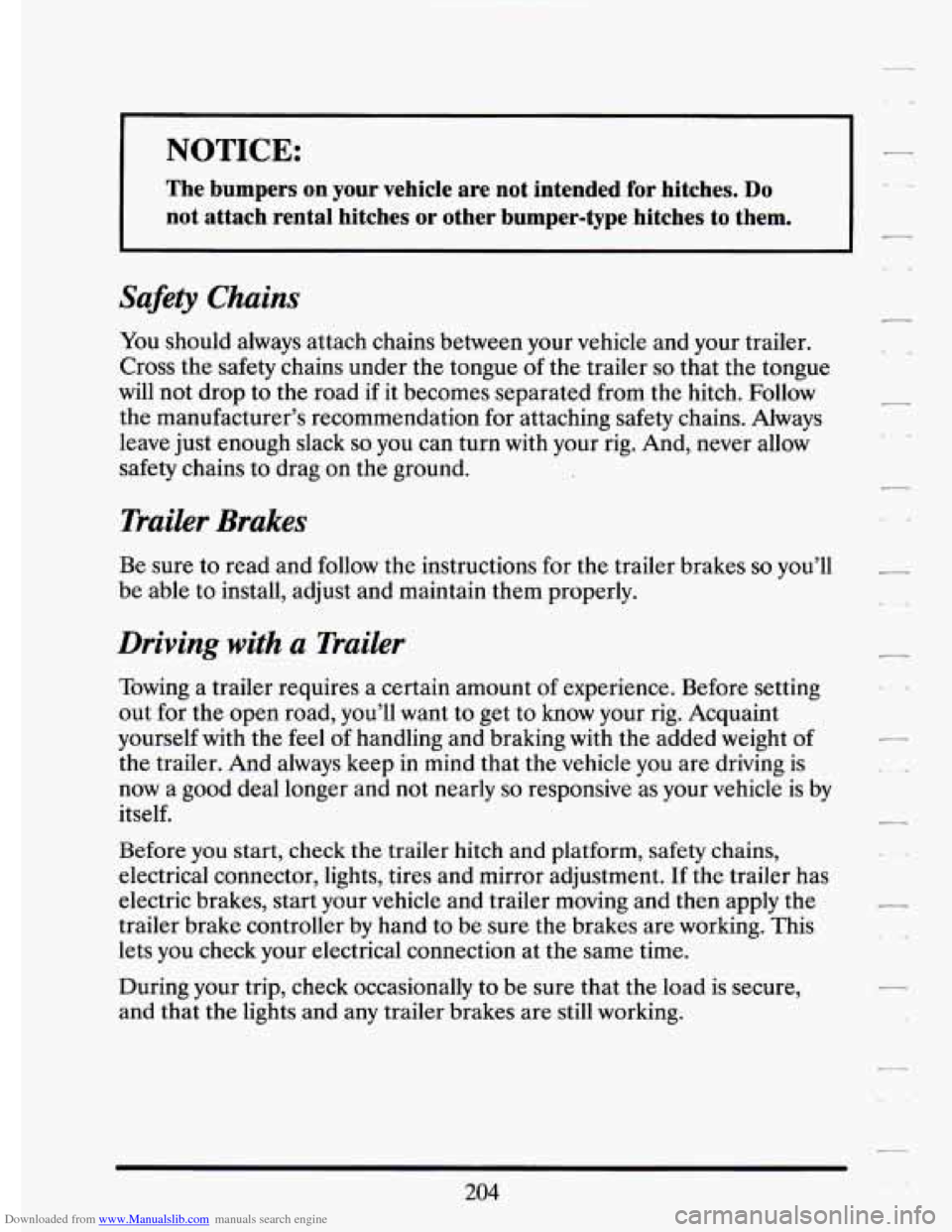
Downloaded from www.Manualslib.com manuals search engine NOTICE:
The bumpers on your vehicle are not intended for hitches. Do
not attach rental hitches or other bumper-type hitches to them.\
-
Safety Chains
You should always attach chains between your vehicle and your trailer.
Cross the safety chains under the tongue of the trailer
so that the tongue
will not drop to the road
if it becomes separated from the hitch. Follow
the manufacturer’s recommendation for attaching safety chains. Alwa\
ys
leave
just enough slack so you can turn with your rig. And, never allow
safety chains to drag on
the ground.
Trailer Brakes
Be sure to read and follow the instructions for the trailer brakes so you’ll -
be able to install, adjust and maintain them properly. L:
Driving with a Trailer
Towing a trailer requires a certain amount of experience. Before setting
out for the open road, you’ll want to get to know your rig. Acquaint
yourself with the feel of handling and braking with the added weight of
the trailer. And always keep in mind that the vehicle you are driving is
now a good deal longer and not nearly
so responsive as your vehicle is by
itself.
Before you start, check the trailer hitch and platform, safety chains,
electrical connector, lights, tires and mirror adjustment. If the trailer has
electric brakes, start your vehicle and trailer moving and then apply the
trailer brake controller by hand to be sure the brakes are working. This
lets you check your electrical connection at the same time.
During your trip, check occasionally to be sure that the load is secure,
and that the lights and any trailer brakes are still working.
204
Page 219 of 398
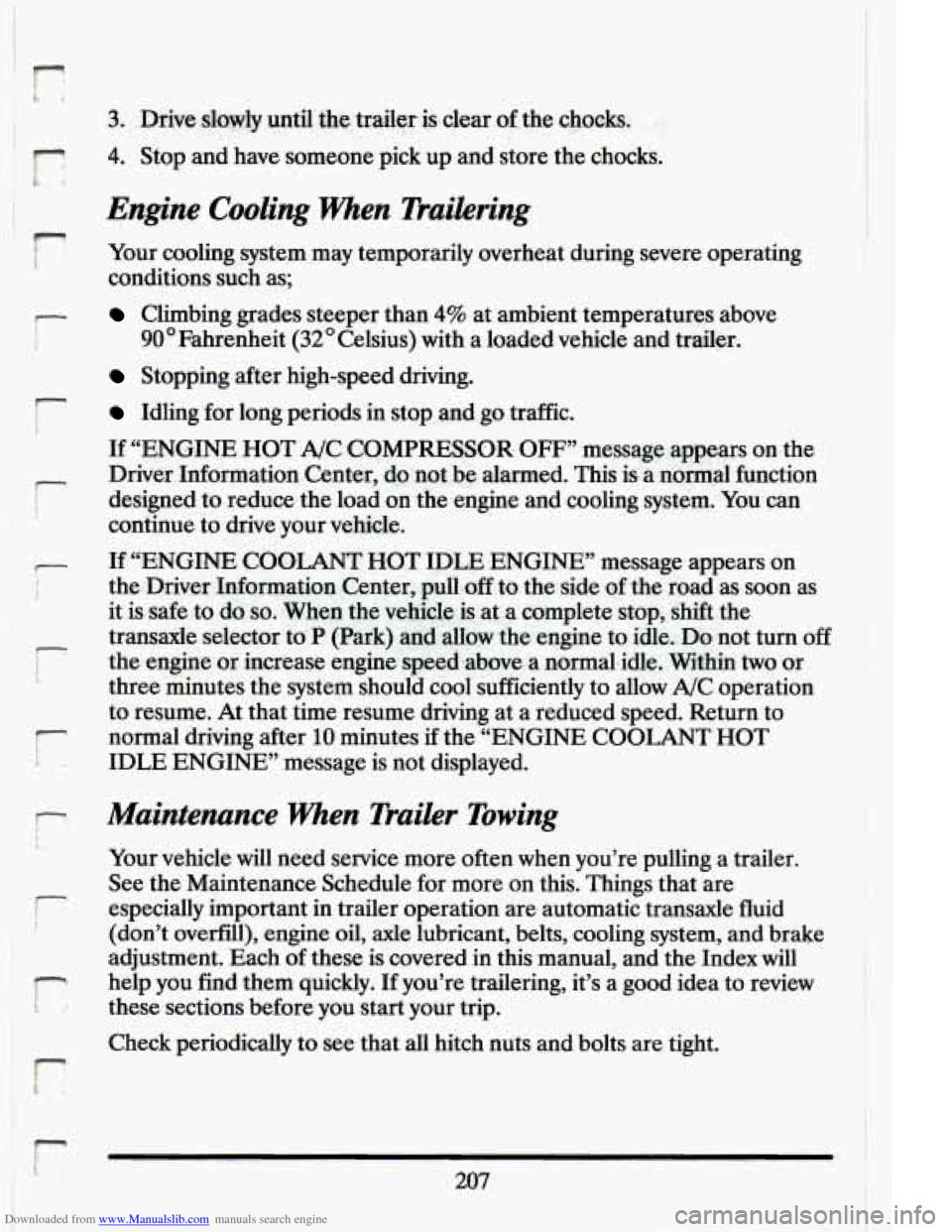
Downloaded from www.Manualslib.com manuals search engine r
F, 4. Stop and have someone pick up .and store the chocks.
Engine Cooling When Tru.ilering
r
I ? Your cooling system may temporarily overheat during severe operating
conditions such as;
Climbing grades steeper than 4% at ambient temperatures above
90” Fahrenheit (32O Celsius) with a loaded vehicle and trailer.
Stopping after high-speed driving.
I
r Idling for long periods in stop and go traffic. I
If ,“ENGINE HOT A/C COMPRESSOR OFF” message appears on. the
Driver Information Center, do.not be alarmed.
This is. a normal function
continue to drive’your vehicle.
the -Driver Information Center, pull
,off to the side of the road as, soon as
it is safe to do
so. When the vehicle is at a complete stop, shift the
transaxle selector to
P (Park) and allow the engine to idle.:Do not turn off
three minutes the system should cool sufficiently to allow A/C operation
to resume. At that time resume driving at a reduced speed. Return to
normal driving after
10 minutes if the “ENGINE COOLANT HOT
- designed. to reduce the load on the.engine and cooling system. You can
- If “ENGINE COOLANT HOT IDLE ENGINE” message.appears on
c
I the engine or increase engine speed.above a normalidle. Wit-hin two or
b- IDLE ENGINE” message is not displayed.
Maintenance When Trailer Towing
i L.
Your vehicle will need service more often when you’re pulling a trailer.
See the Maintenance Schedule for more on this. Things that are
(don’t overfill), engine oil,
axle lubricant, belts, cooling system, and brake
adjustment. Each
of these is covered in this manual, and the Index will
these sections before you start your trip.
i especially important in trailer operation are, automatic transaxle fluid
7 help you find them quickly. If you’re trailering, it’s a good idea to review
I
‘F
Check periodically to see that all hitch nuts and bolts are tight.
r 207
Page 241 of 398

Downloaded from www.Manualslib.com manuals search engine !r
r
r
r L
I-
‘.. c ..e
IF A TIRE GOES FLAT
It’s unusual for a: tire to “blow out” while you’re driving, especially if you
maintain your tires properly. If air goes out of a. tire, it’s much more ‘likely
to leak out slowly.
But if you should ever have a “blowout,” here are a
few tips about what to expect and what to do:
If a front tire fails, the flat tire will create a drag that pulls the vehicle
toward that side. Take your
foot, off .the accelerator pedal and grip- the
steering wheel
firmly. Steer to maintain lane position, then-gently brake
to a stop well out of the traffic lane.
A rear blowout, particularly on a curve, acts much like a skid and may
require the same correction you’d use in a skid. In .any rear blowout,
remove your foot from the accelexator pedal. Get the vehicle under
control by steering the way
you want the vehicle to go. It may be very
bumpy and noisy, but you can still steer. Gently brake to a stop, well
off
the. road.if possible.
If a tire goes flat, the next section shows how to use your jacking
equipment to change a flat tire safely.
. . ._ .. . .
229
Page 255 of 398
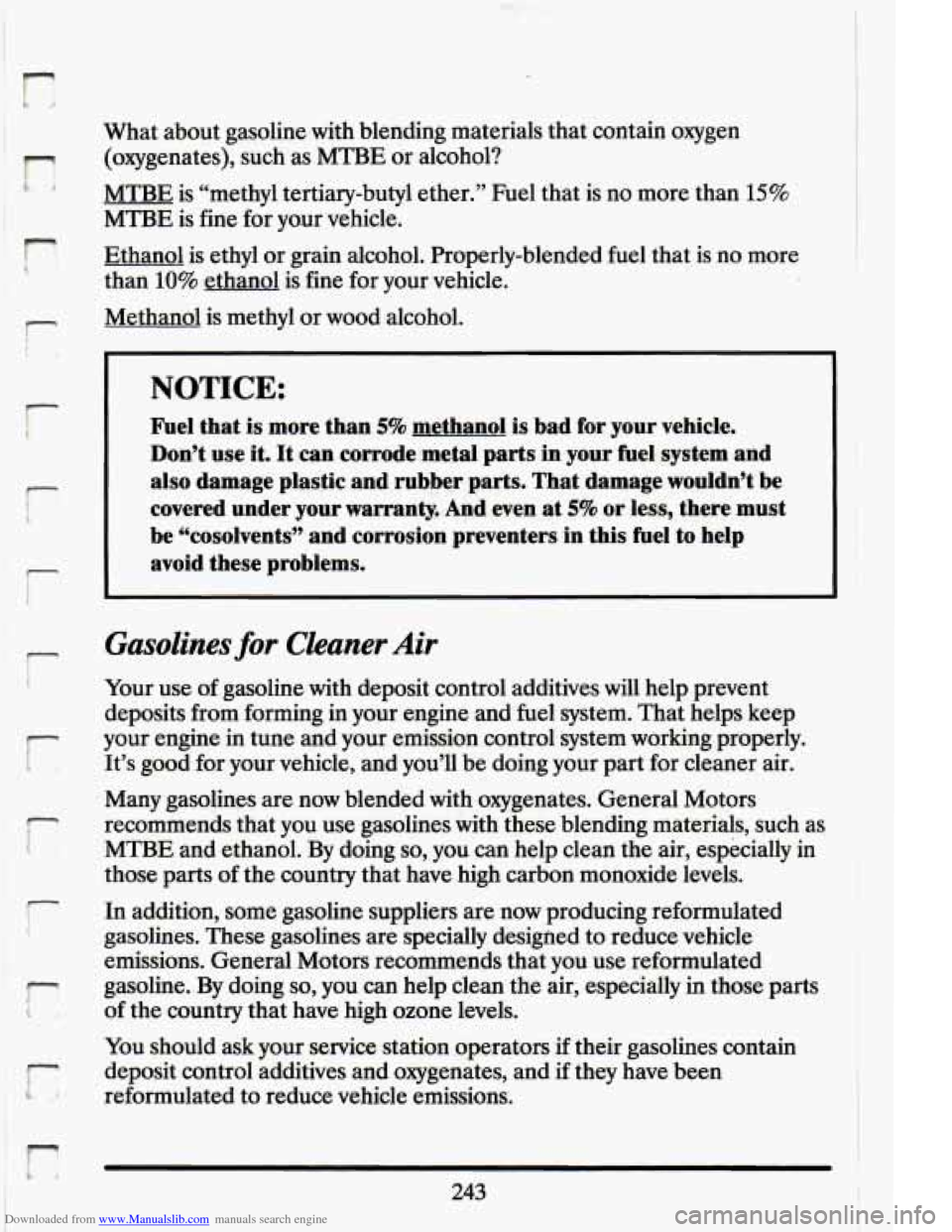
Downloaded from www.Manualslib.com manuals search engine r
r
r
j
1
What about gasoline with blending materials that contain oxygen
(oxygenates), such as
MTBE or alcohol?
MTBE is “methyl tertiary-butyl ether.” Fuel that is no more than
15%
MTBE is fine for your vehicle.
Ethanol is ethyl or grain alcohol. Properly-blended fuel that is no more
than
10% ethanol is fine for your vehicle.
Methanol is methyl or wood alcohol.
NOTICE:
Fuel that is more than 5% methanol is bad for your vehicle.
Don’t use it. It can corrode metal parts in your
fuel system and
also damage plastic and rubber parts. That damage wouldn’t be
covered under your warranty.
And even at 5% or less, there must
be %osolvents” and corrosion preventers
in this fuel to help
avoid these problems.
Gasolines for Cleaner Air
Your use of gasoline with deposit control additives will help prevent
deposits from forming in your engine and fuel system. That helps keep
your engine in tune and your emission control system working properly.
It’s good for your vehicle, and you’ll be doing your part for cleaner air.
Many gasolines are now blended with oxygenates. General Motors
recommends that you use gasolines with these blending materials, such as
MTBE and ethanol. By doing so, you can help clean the air, especially in
those parts of the country that have high carbon monoxide levels.
- In addition, some gasoline suppliers are now producing reformulated
gasolines. These gasolines are specially desighed to reduce vehicle
emissions. General Motors recommends that
you use reformulated
F gasoline. By doing so, you can help clean the air, especially in those parts
i of the country that have high ozone levels.
F?
You should ask your service station operators if their gasolines contain
deposit control additives and oxygenates, and if they have been
reformulated to reduce vehicle emissions.
243
Page 257 of 398
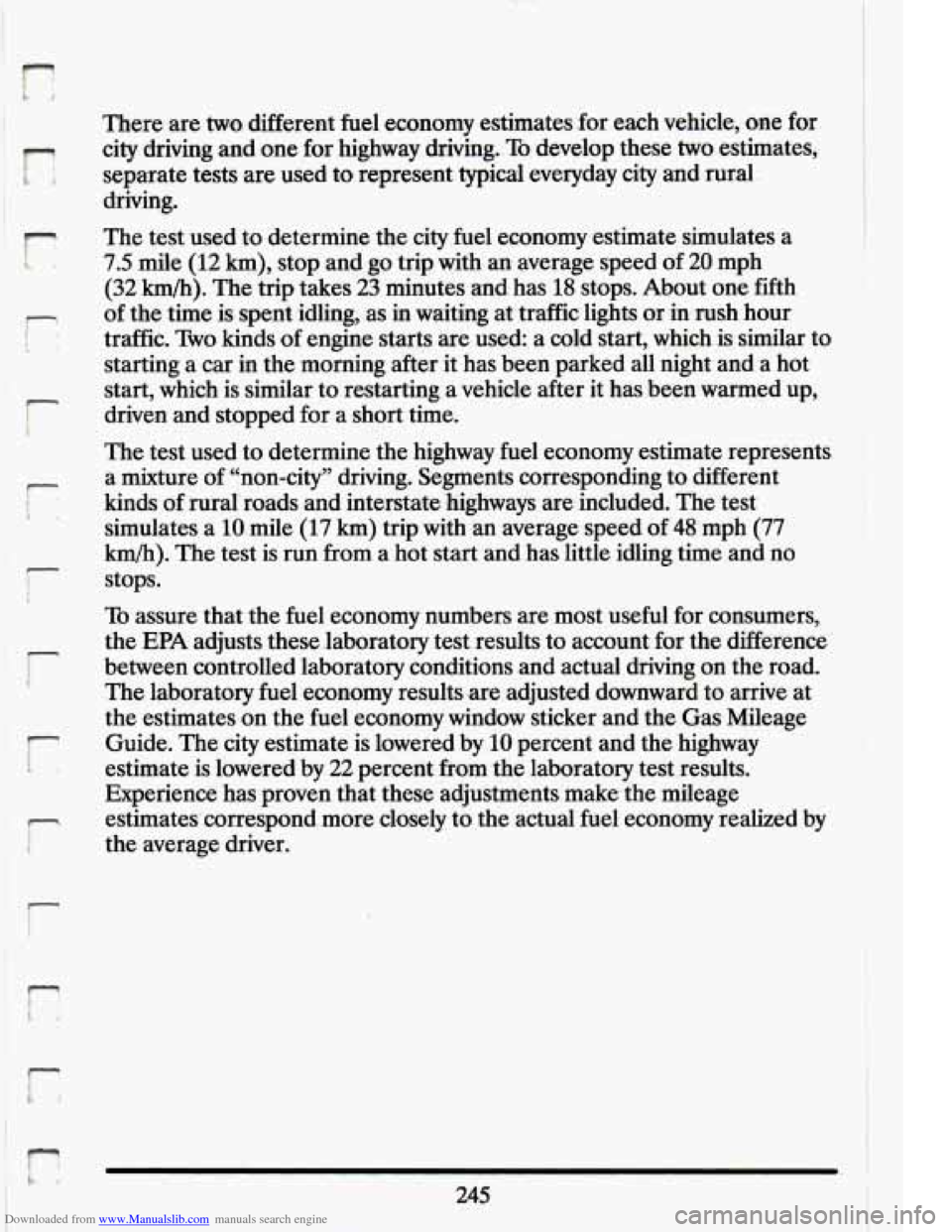
Downloaded from www.Manualslib.com manuals search engine r
I’
r
i
i-
i r
There: are two;different fuel economy estimates ,for each vehicle., one for.
city driving
and one for highway driving ... To develop these two .estimates,. ;
separate tests .are used to represent typical everyday city and rural
driving.
The test used to determine the city fuel economy estimate simulates a
7.5 mile (12 km), stop and go trip with. an average speed of 20 mph
(32 km/h). The trip takes 23, minutes and: has 18 stops. About one fifth
of the time is spent idling, as in waiting at traffic lights or in rush hour
traffic.
Two. kinds of engine starts are used: a cold start, which is similar to
starting a car in the morning after it has been parked all night and a hot
start, which is similar to restarting a vehicle after it has been warmed up,
driven and stopped for a short time.
I
!
i j I i
The test used to determine the highway fuel economy estimate represents
a mixture of “non-city” driving. Segments corresponding to different
kinds of rural roads and interstate highways are included. The test
simulates a
10- mile (17 km) trip with an average speed. of 48 mph (77
km/h). The test is run from a hot start and has little idling time and no
stops.
To assure that the fuel economy numbers are most useful for consumers,
the EPA adjusts. these .laboratory test. results. to account for the difference
between controlled laboratory conditions and actual, driving on the road.
The laboratory fuel economy results are adjusted downward
to arrive at
the estimates on the fuel economy window sticker and the
Gas Mileage
Guide. The city estimate is lowered by
10 percent and the highway
estimate is lowered by
22 percent from the laboratory test results.
Experience has proven that these adjustments make the mile:age
estimates-correspond more closely to the actual fuel economy realized
by
the average driver.
245
Page 272 of 398
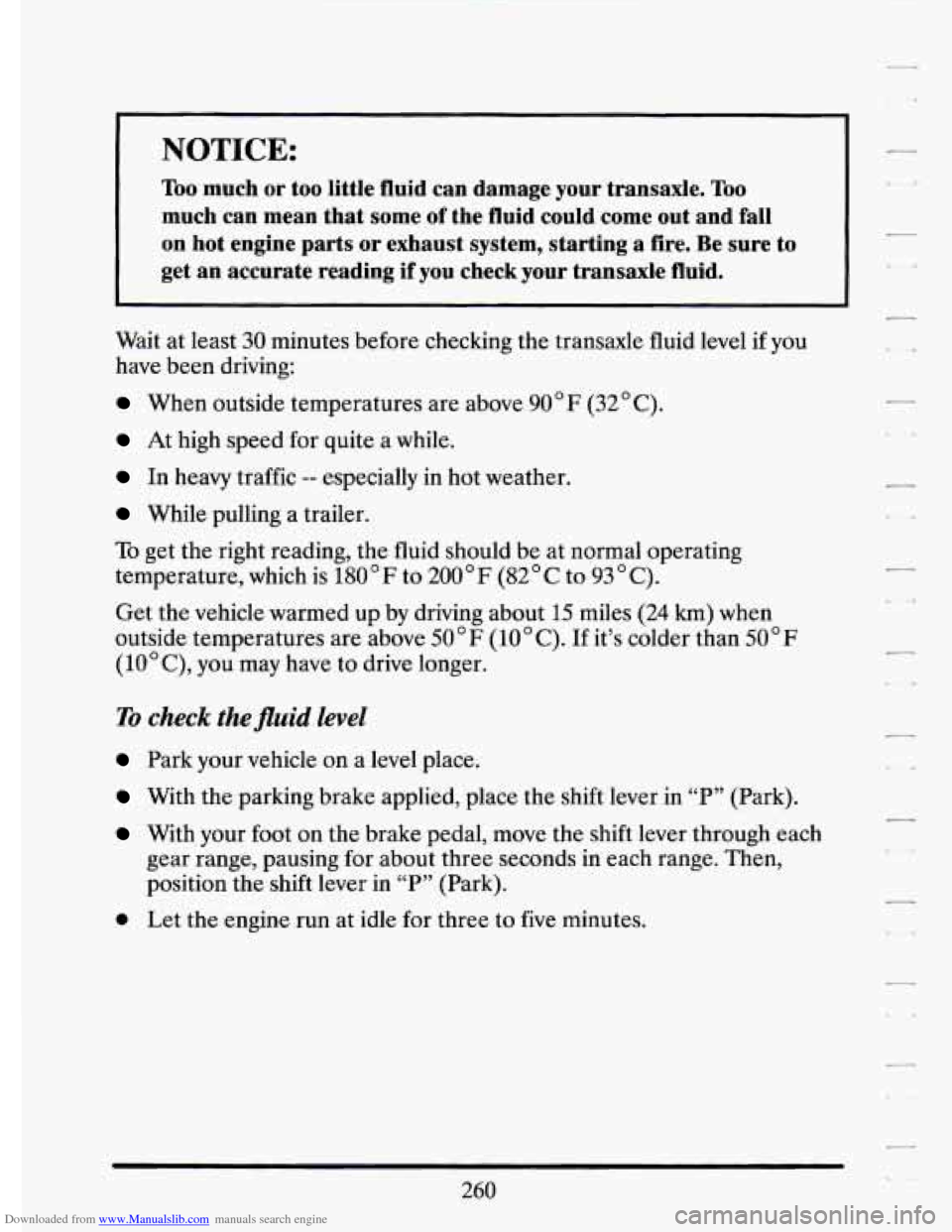
Downloaded from www.Manualslib.com manuals search engine NOTICE:
Too much or too little fluid can damage your transaxle. Too
much can mean that some of the fluid could come out and fall\
on hot engine parts or exhaust system, starting a fire.
Be sure to
get an accurate reading
if you check your transaxle fluid.
Wait at least 30 minutes before checking the transaxle fluid level if you
have been driving:
When outside temperatures are above 90'F (32" C).
At high speed for quite a while.
In heavy traffic -- especially in hot weather.
While pulling a trailer.
To get the right reading, the fluid should be at normal operating
temperature, which is
180 F to 200 ' F (82' C to 93 C).
Get the vehicle warmed up by driving about 15 miles (24 km) when
outside temperatures are above
50 "F (10'C). If it's colder than 50'F
(lO'C), you may have to drive longer.
To check the fluid level
Park your vehicle on a level place.
With the parking brake applied, place the shift lever in "P" (Park).
With your foot on the brake pedal, move the shift lever through each
gear range, pausing for about three seconds in each range. Then,
position the shift lever in
"P" (Park).
0 Let the engine run at idle for three to five minutes.
260